History of
Automobiles
The Early Days in Nova Scotia
1899-1949
Special Topics:
• # 1923: Roads change from left to right
1899 September 11
The First Automobile
The first automobile ever seen in Nova Scotia, arrived on the Allan liner Siberian from Liverpool [England] this morning. It is a gasoline horseless carriage, owned by William Exshaw, son-in-law of Sir Sanford Fleming. It was built in France and has been run by Mr. Exshaw since the first of the year. The propelling motor is operated by gasoline. The automobile is boxed up, but Mr. Exshaw expects to be driving it around the streets in a few days.
[Quoted whole from the Halifax Daily Echo, 11 September 1899]
|
On 12 April 1898, John Moodie imported a Winton automobile to Hamilton,
Ontario, the first gasoline-powered automobile brought to Canada.
[National Post, 12 April 1999]
|
1904
First Cars Sold in Nova Scotia
William H. MacCurdy in his history of the MacKay car produced in Nova Scotia tells of the first cars in the Province. "In the spring of 1904 Archie Pelton along with Mr. Porter of Kentville, a successful businessman went to the first automobile show in New York city. Here they bought two Curved Dash Oldsmobiles and had them shipped to Nova Scotia. These were the first two cars in the province for resale. In 1904 there were 15 other cars in the Province, but these had been bought by their owners in the United States."
Source:
Pictou County Reminiscences: Highways by Stanley Graham, Scotsburn
http://www.rootsweb.com/~pictou/hiwaysg.htm
The Wayback Machine has archived copies of this document:
Pictou County Reminiscences: Highways
Archived: 1997 May 8
http://web.archive.org/web/19970508083330/http://www.rootsweb.com/~pictou/hiwaysg.htm
Archived: 1999 May 6
http://web.archive.org/web/19990506091854/http://www.rootsweb.com/~pictou/hiwaysg.htm
Archived: 1999 October 9
http://web.archive.org/web/19991009012023/http://www.rootsweb.com/~pictou/hiwaysg.htm
Archived: 2000 January 6
http://web.archive.org/web/20000106223052/http://rootsweb.com/~pictou/hiwaysg.htm
Archived: 2000 July 8
http://web.archive.org/web/20000708080510/http://www.rootsweb.com/~pictou/hiwaysg.htm
Archived: 2001 June 20
http://web.archive.org/web/20010620075419/http://rootsweb.com/~pictou/hiwaysg.htm
Archived: 2001 November 24
http://web.archive.org/web/20011124043208/http://www.rootsweb.com/~pictou/hiwaysg.htm
|
1907 March 19
Building a Benzine Buggy
The automobile habit promises to be prevalent here next summer. Already we are informed Mr. Fanjoy has booked his order for one and is having a garage built, while two other young men of a mechanical turn of mind have decided not to go abroad for their benzine buggy but are manufacturing one in Fraser Brothers foundry.
[New Glasgow Eastern Chronicle, 19 March 1907]
1907 April 2
Automobile Craze Taking Hold
The automobile craze is taking hold. Now, Mr. A.R. Munro tells us that he has purchased one, a Russell ... The machine will carry five and is of the very best make.
[New Glasgow Eastern Chronicle, 2 April 1907]
1907 April 19
Automobile Fever
The automobile fever is catching. Messrs. Fanjoy have theirs in the garage awaiting better roads and others are en route here. By the time the mud disappears the chug-chug noise will be quite common. One prominent horseman is so attacked with the disease that he is said to be quietly disposing of his stable outfit and spends his spare moments studying auto catalogues. The horsemen need not get alarmed that the motor car will injure their business in our country.
[New Glasgow Eastern Chronicle, 19 April 1907]
1907 April 28
First Motor Vehicle Law Takes Effect
The Motor Vehicle Law went into effect April 28, 1907, providing for the registration of motor vehicles, the licencing of mechanics and employee-drivers as chauffeurs, and the registration of auto dealers. The one-time fee for auto registration was five dollars.
History of Nova Scotia licence plates
http://www.gov.ns.ca/snsmr/rmv/registration/historic.stm
1907 April 30
About the Running Stinkers
Editor of Eastern Chronicle Dear Sir: Kindly advise through the columns of your esteemed paper — If a person driving a team should happen to meet one of those Benzine Cars [automobiles] and his horse taking fright, his rig is demolished or perhaps the occupants are seriously injured, can the driver of the team recover damages from the motorist? I am one who doesn't own an auto — but one who is likely to get run over.
Editor's comment: Damages depend on several things. Were the occupants of the gasoline devil exceeding a reasonable speed limit, say six miles an hour? When they saw the driver of the horse in difficulties did they stop? Did they unreasonably crowd the horse vehicle? And half a dozen other things would come up in a court. The auto people have the right to use the public roads, but they must do so in a reasonable manner. If they go rushing about the country regardless of whom they may annoy or injure they can be hauled up with a round turn, but as long as they are careful and regulate to statutory speed their right is undeniable. This is as it seems to us; but a lawyer who is familiar with the statutes might change some of what we have stated.
Talking off our own bat we would not be afraid to meet a speed devil with any horse properly broken and properly rigged, providing the auto driver did not blow his confounded conch. Coming from behind, that uncivilized 'honk honk' frightens a horse out of his wits. If an auto comes quietly up behind a horse and passes when there is room there is no danger if the driver of the horse does not lose his head as so many do in an emergency. Coming head on where the man on the red devil is conspicuous a horse does very well but the 'honk' of the thing frightens the animal a great deal.
It might be a good plan to get one of the conchs and blow it about the stable until the horse gets used to it. A horse that has been used about a quartz crushing mill is not afraid of steam cars the first time he sees them, because the noise does not terrify. This writer had a horse one time that loose paper flying about the streets would set unmanageable. He gathered all the crinkly paper a dry goods firm would give him and put them into the box with the horse. That cured him in no time, although he cut up great capers when the papers were shook up about him in the box on the pretence that his bed was being made up and in a short time he concluded that loose paper on the streets was a sheet of his bed away from home.
However, a good plan is for the driver not to take a fit before the horse takes one. The former is generally the case. A year ago three or four men were in here in a touring machine from Amherst. I asked the driver if many horses were frightened on the way? "None," he replied, "but lots of drivers had fits," which is generally the case. We went into the car and were taken up Provost Street and down Archimedes. On the way down the latter the car overtook a carriage driven by a woman. As he turned out to pass, we said, "Be careful, that woman's horse may be frightened." He peered round at the horse and put on full stink ahead. The woman clutched the arm of the wagon seat and wriggled, but the horse took no notice. But one might write a book on this thing and the next morning might get run over a bank by one of the red devils, and there you are. Fortunately we don't meet death or even injury by any known rule.
[New Glasgow Eastern Chronicle, 30 April 1907]
1907 May 8
Licence Plate Number One
Plate #1 was issued May 8, 1907 to Mr. William Black, Wolfville, for an Oldsmobile Touring Car. #62 was the last number issued that year. #13 was not issued.
Source: Registry of Motor Vehicles
A History of Nova Scotia Licence Plates: 1907-1919 by David Fraser
http://www.gov.ns.ca/snsmr/rmv/registration/history/plt07-19.stm
1907 June 14
Another Big Stink Wagon
Mr. A.J. McDearmid had a party of friends out on Wednesday evening for a spin in his beautiful new touring car, which he has imported from Boston. It is a Rambler and is a magnificent looking car.
[New Glasgow Eastern Chronicle, page 1, 14 June 1907]
Note: The item immediately above, and the one immediately below,
both here quoted whole, were printed on the same page
in adjacent columns, barely 5 cm apart.
Another of the big stink wagons in town, the property of Mr. A.J. McDearmid.
[New Glasgow Eastern Chronicle, page 1, 14 June 1907]
1907 June 25
Mortal Terror
Editor, Eastern Chronicle Dear Sir: Can you tell the owner of a fractious horse if he has any right at all to the King's highway when he meets an automobile? For the past few days I along with other natives of this section of the vineyard have been kept in mortal terror of one of these devil wagons meeting us when we are driving along the road, our horse taking the nearest fence and leaving us stranded on the roadside, possibly maimed for life, and our good looks considerably out of joint. There surely should be some legislation for the people who maintain the roads and who in their daily avocation are constantly called on to use these roads. Their rights should be protected against these life endangering pleasure jaunters. Yours etc., Mac.
Editor's Note: We believe an Act was passed by the House of Assembly last session, dealing with the running of automobiles in the Province. We shall look it up and publish the gist of it for the benefit of our correspondent and others in the same fix, who possibly may be more afraid of the machines than are the horses they drive. We may say now that we are told the speed of the stink wagons is limited to a mile in 8 minutes [12 km/h]. On passing a team if the driver of the team holds up his hands, the Chauffeur of the stink wagon must bring it to a standstill and remain in that condition until the driver of the horse gives permission to start. We are not sure that the Chauffeur must not get down and lead the horse past.
[New Glasgow Eastern Chronicle, page 2, 25 June 1907]
1907 June 25
Devil Wagons
New Glasgow during the past week has got another of the 'devil wagons'. Possibly more will follow. This is free country — within certain limits. However, we feel fairly certain that besides the danger and injury inflicted these 'devil wagons' will lose the merchants of the town thousands of dollars worth of trade, because the country people will not, and justly so, risk their lives, coming or going from town, by meeting one of these machines. Our roads are so narrow that it is seldom that two carriages pass except at a walk. When such is the fact, what is the driver of a horse to do when one of these 'devil wagons' bears down on him? If his horse is at all unused to them he is bound to be upset.
The other day a minister from an adjoining county was going towards Trenton when he met a tram car. He was upset, his wagon broken, and he is himself laid up in Truro. The tramcars do not frighten a horse as badly as a 'devil wagon'. Last Saturday two men belonging to the town were coming in along the East River Road just beyond the railway crossing, with a strange horse, when a 'devil wagon' flashed up over the hill on them. The horse shied, the wagon was upset, and the horse was badly hurt and is now laid up for repairs in Weir's stable and the owner is put to loss and inconvenience. The men were both bruised, and, of course, hurt, but not seriously. If we have to put up with them, drivers of horses will be driven off the roads. Drivers of horses are mostly on business, but the 'devil wagons' are used for fun. Has the whole county, whose people built the roads for their own use in order to do their work, to put up with these pleasure jaunters?
[New Glasgow Eastern Chronicle, page 4, 25 June 1907]
1907 June 25
One Mile in Eight Minutes
According to law every owner of an automobile must register it with the Provincial Secretary. The machine must be numbered in large letters at least three inches 7.6cm long, white on black ground.
The allowed speed is one mile in eight minutes 12 km/h in a town, one mile in five minutes 19 km/h in a village, and one mile in four minutes 24 km/h in the country. The countryman gets it in the neck.
The burden of care is placed on the auto owner and driver. It is for them to take care of persons or vehicles. The auto must stop on being signalled by raising a hand by a person having in charge a horse or horses, and remain standing until the horses and driver are out of harm's way. Otherwise the rules of the road are observed, but if the auto driver is not signalled the burden of care is on him.
Any person who desires to run an automobile must file his name with the Provincial Secretary and pay a registration fee of two dollars. (We wish it were two hundred dollars.) The chauffeur will then be given a badge not longer than 3 inches 7.6 cm diameter which he must fasten to his clothing. (We wish it were as big as a board on a cow's face.)
[New Glasgow Eastern Chronicle, page 5, 25 June 1907]
1907 July 2
Halifax Street-Paving Contract
The Barber Asphalt Company of New York, represented in Nova Scotia by Robert Low, have secured the contract for paving the Halifax streets. It is a $75,000 job.
[New Glasgow Eastern Chronicle, 2 July 1907]
1907 July 2
A Dire Menace
The country people are asking us continually if days cannot be advertised that automobiles will not be on the roads so that they can safely use the roads and come to town. In a number of cases women from the country do the shopping, driving their teams to town with butter, eggs, etc., and exchanging them for household necessities. No woman and few men can drive a horse unused to automobiles past one of these chug-chug machines. The roads are so narrow that teams can seldom pass except at a walk, how then can a person drive a skittish horse past a devil wagon on them? This is a subject that is of great importance not only to the country people, but also to the people of the town, especially to the merchants. no one will wish to come to town at the risk of his or her life; he or she cannot be expected to come.
We are aware that we are subjecting ourselves to severe and hostile comment in writing along this line; but we feel that we must. Automobiles can serve no end here except furnishing pleasure for a few people. The roads are narrow and they were constructed by the people for the people so that they could attend to their legitimate business; is it then reasonable or patriotic for a few persons to drive them off their own roads so that these pleasure and excitement seekers should have the fun of running automobiles?
The law is very strict and supersedes municipal regulations, yet is inept. On its face it looks as if the Legislature deliberately passed it in such form as to gather in some revenue by a system of licensing these machines. Even the speed at which they are allowed to be driven in the country districts (15 miles an hour 24 km/h) is a dire menace to the safety of the lives of drivers of teams! Fancy one of these wagons rounding a turn on our side hill roads at 15 miles an hour on a horse and wagon driven by a woman, and as is often the case, children in the wagon with her? The law should give municipalities the power to forbid them the use of our roads at all. Were it a level country and the roads 60 feet 18 metres wide a team would have some chance; as it is, they have none and death stares them in the face when one of these machines bears down on them. They should all be permanently housed or shipped out of the country.
In this connection it is worth noting that the Legislature forbad them running on the roads in Point Pleasant Park in Halifax. Why then do they allow them to run on the narrow and steep country roads. It looks to us as if the Members from the country were asleep when the license was given to them to run on the country roads.
[New Glasgow Eastern Chronicle, page 1, 2 July 1907]
1907 July 2
Watering the Streets
The Editor was coming back from the Post Office, Friday morning, when he was accosted by Mr. Bentley, who was perched on the water wagon and had just been at work watering the streets ...
[New Glasgow Eastern Chronicle, page 1, 2 July 1907]
1907 July 9
Fearless Horse
Coming along the road one morning lately driving Achille [the editor's horse] we met Mr. Fanjoy with his auto this side of the Potter's bridge on the narrowest part of the road. Mr. Fanjoy, when near, stopped the machine. He was hailed with: "Start her up, Mr. Fanjoy, you can't scare this fellow." If Achille saw the auto he made no sign. What a blessing it would be to every man who keeps a horse if he had one as fearless as Achille. Yet here is something more. When a train or such like is passing him if the driver picks him up sharply he will dance like other horses; if the driver makes no sign he takes no notice.
[New Glasgow Eastern Chronicle, page 1, 9 July 1907]
1907 July 9
The Common Enemy
Last week was a hard one on live stock hereabout. On Friday the common enemy, the automobile, got next to a cow on the East River Road, broke her up so badly that Policeman Chisholm had to destroy her. The damage was done in the vicinity of ten o'clock at night and just who the motorists were was a conundrum but the police think they have now located the machine, one owned by E. McQuarrie, of Lorne, that was in town for repairs. Mr. McQuarrie was not there himself. The worst feature of the affair was that the motorists never stopped to survey the damage or report the accident to anyone but pumped right on. The animal killed belonged to John Small and was valued at $50 and is a serious loss. No doubt the cow was a trespasser being loose at that hour on the street, but this was no fault of the owner, as she got out of pasture in the afternoon, had been impounded by the police and broken pound later on. Mr. Small was in search of the strayed animal when the automobile overtook her. The offence of the cow was in the vicinity of two dollars while the motorists, if we decipher the act aright, were committing a $50 violation of the law by being abroad, no doubt without a license and minus proper danger signals.
[New Glasgow Eastern Chronicle, page 1, 9 July 1907]
1908 March
Kings County Good Roads Association
NSL 1908 chapter 53 — Motor Vehicle Act
1908 December 4
Good Sleighing Needed
Our Digby merchants are beginning to feel the effects of the holiday trade which is commencing early this year. What we need is good sleighing to make times [business] brisk.
[Digby Weekly Courier, 4 December 1908]
1909 June 28
Windsor Man Badly Injured
Fred Curry, of Curry Bros., Windsor, left Halifax on Monday evening, June 28th, 1909, to ride to Windsor in his automobile. He had got less than three miles five km on his journey when he ran over an embankment on the shore of Bedford Basin. His car missed the road. People who saw the accident ran down and found Curry pinned beneath his machine. He was released and taken to the hospital, where it is believed he will recover. The automobile was still at the roadside at midnight, when men went out to bring it back to town.
[Digby Weekly Courier, 2 July 1909]
1910 April
Nova Scotia Carriage Company
(soon to become the manufacturer of the MacKay Automobile)
NSL 1910 chapter 78 — Act to authorize the town of Kentville to exempt the Nova Scotia Carriage Co. Ltd.
1910 April
Automobiles Prohibited on Saturdays and Sundays
in Kings County
Motor Vehicles Resolved that the following regulations be
made under and by virtue of chapter 53 of the Acts of the Legislature
of Nova Scotia for the year 1908, namely, that the use and operation of
Motor Vehicles upon any of the public highways of the Municipality
of the County of Kings, on Saturday and Sunday of each week
is hereby prohibited, and that any person violating the
Regulations shall be liable to a penalty not exceeding
$50 for the first Offence, and not exceeding $100
for a second Offence, and not exceeding $200 for
a third Offence.
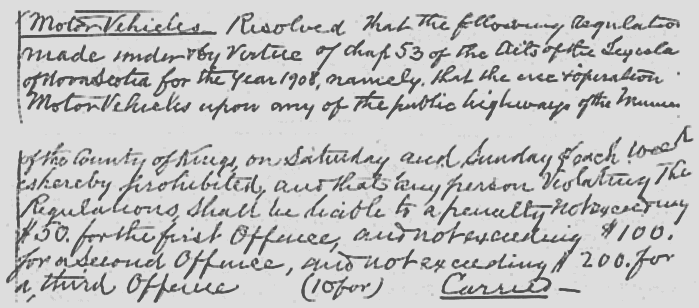
Source: Official Minute Book of the Municipality of Kings County, 1890-1913
pages 596 and 597, April 1910
1910 May 17
Automobile Party
Messrs. Pickles, Fred Harris and Samuel Rippey arrived in Digby from Annapolis Tuesday morning, May 17th, 1910, accompanied by Mr. Harris' little boys in an automobile owned by Mr. Pickles. Here they met a handsome new Ford machine just purchased by Mr. Harris and landed in Digby, via S.S. Yarmouth. Both machines left Digby for Annapolis in the afternoon, the party being joined here by Mr. Buckler, the acting customs officer at this port, who accompanied them to Annapolis, returning via the Dominion Atlantic Railway.
[Digby Weekly Courier, 20 May 1910]
1910 June 3
Watering the Streets of Digby
Tenders for watering the streets of the Town of Digby will be received at the office of the Town Clerk up to and including June 7th, 1910, from parties willing to contract with the Town of Digby for watering the streets at such times as may be required during the present summer. Forms of tender and plans of streets to be watered may be seen at the Town Clerk's office. The lowest or any tender not necessarily accepted.
[Digby Weekly Courier, 3 June 1910]
During the summer, traffic raised enormous quantities of dust which drifted into houses and shops along the unpaved streets of all towns and villages. This was a serious nuisance for people trying to keep their premises clean, and many local governments spent money to have water sprayed on streets to reduce the clouds of dust. In the 1930s and 1940s, water sprays were replaced by spreading granules of calcium chloride on unpaved streets and roads. As recently as the summer of 2003, I saw a truck spreading calcium chloride on an unpaved road in Pictou County, for dust control.
Calcium chloride by Wikipedia
1910 July 22
Purchased an Auto
Mr. Geo. M. Wilson has purchased from Mr. Harry Gavel a Ford touring car which he will use in the tourist business in Digby and vicinity. This should prove to be a profitable investment as many prefer an auto instead of horses on the numerous beautiful drives for which Digby is noted as a summer resort. Mr. Gavel is an extensive dealer in automobiles and has recently sold several in Nova Scotia, all of which are giving excellent satisfaction.
[Digby Weekly Courier, 22 July 1910]
Digby Automobile Tours
Digby Weekly Courier
29 July 1910
His automobile is ready for trips to Bear River, Annapolis,
or any place in the vicinity of Digby to which an auto can go.
Telephone eighty ring three.

Digby Weekly Courier, 29 July 1910
1910 July 29
Digby Speed Limit
No automobile shall be driven through the streets of the Town of Digby
at a speed exceeding six miles per hour ten km/h and the drivers of
automobiles shall keep the horn sounding while approaching and
passing any person driving, walking or standing upon the streets.
The penalty for a violation is $30.00 or sixty days in jail.
("Driving" means anyone driving a horse and wagon or carriage or sleigh.)
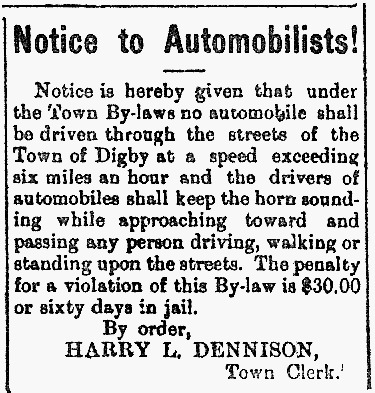
Digby Weekly Courier, 29 July 1910
1910 July 31
Fifty-Mile Auto Trip
Mr. Arthur Harris, of Glace Bay, Cape Breton, who resided in Little River some eighteen years ago, was in Digby on Monday, August 1st, 1910, accompanied by his little daughter. On Sunday, July 31st, Mr. Harris enjoyed a fifty-mile eighty km automobile trip with his brother, Mr. Fred Harris, the town clerk of Annapolis.
[Digby Weekly Courier, 5 August 1910]
1912 August 27
The First Trans-Canada Auto Trip
Departed Halifax: 27 August 1912
Arrived Victoria: 17 October 1912
In 1912, Thomas Wilby and Jack Haney drove a 1912 REO automobile across Canada. It was the first Trans-Canada automobile trip. In 1997, Lorne, Irene, and Peter Findlay will re-trace Wilby and Haney's historic route in their own 1912 REO. Accompanying them will be Ontario writer John Nicol.
Source (found in the Google cache):
http://www.google.com/search?q=cache:stargate.vsb.bc.ca/
autotour/+first+trans-canada+trip&hl=en
The Wayback Machine has archived copies of this document:
The First Trans-Canada Auto Trip
(stargate.vsb.bc.ca "vsb": Vancouver School Board)
Archived: 1998 December 1
http://web.archive.org/web/19981201033559/http://stargate.vsb.bc.ca/autotour/
Archived: 1999 October 6
http://web.archive.org/web/19991006003128/http://stargate.vsb.bc.ca/autotour/
|
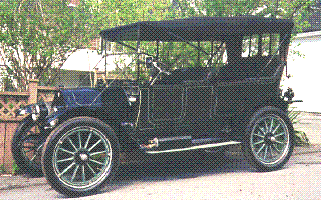
1912 REO automobile
Source:
http://web.archive.org/web/19991008181915/stargate.vsb.bc.ca/autotour/vehicles.htg/reo320-2.gif
The name came from the initials of manufacturer Ransom Eli Olds,
(whose name also appeared in the Oldsmobile).
REO Motor Car Company
http://liptrap.topcities.com/reo.htm
The first cross-Canada road trip was in 1912, when Thomas Wilby and Jack Haney drove their four-cylinder REO from Halifax to Victoria in just under two months. "Roads were bad," Mr. Haney wrote in his diary on just the second day of the expedition. By the time they reached Ontario, the roads were "rotted, full of deep holes. Had to ford two creeks today, bridges out." The trip coincided with public calls for a national highway, but it was 1949 before the Trans-Canada Highway Act was passed by the House of Commons, committing the federal government to paying half the estimated $300,000,000 cost. Construction was to end by December, 1956, but proved more difficult than anticipated, particularly in the B.C. avalanche zone between Golden and Revelstoke, and on the tunnel beneath the St. Lawrence River at Boucherville, Quebec...
[National Post, 29 June 1999]
Earliest Drive Across Canada
Letter to Editor
Further to your Canada Day questions and answers (The Sunday Herald, 1 July 2001), I wish to note an error in the answer to question 9.
Thomas Wilby and F.V. Haney, in their 1912 motor trip, did not drive across Canada. At least one or several portions of their journey were done by transporting their vehicle on a railway train. A trans-Canada motor trip was not possible until a Canadian highway link was completed in 1943.
Then in May of 1946, Brigadier R.A. Macfarlane, DSO, and Squadron Leader K.A. MacGillivary dipped the rear wheels of a new post-war Chevrolet in the waters of the Atlantic Ocean at Louisbourg, Nova Scotia, and nine days and 4,743 miles 7636 km later, dipped the front wheels in the Pacific Ocean at Victoria, British Columbia. By this accomplishment, Macfarlane and MacGillivary were the recipients of the A.E. Todd Gold Medal first offered in 1912 by the then mayor of Victoria.
W.J. Phillips, Halifax
[Halifax Sunday Herald, 15 July 2001]
1914 April
Kings County Good Roads Association
NSL 1914 chapter 12 — Act to incorporate the Kings County Good Roads Association
circa 1917
1917 Garage Photograph
Photograph of Trefry's Garage, Central and Brown Streets, Yarmouth circa 1917
http://www.yarmouthweb.com/oldpix/trefrys_garage_central_and_brown_circa1917.jpg
1919 February 5-6-7
Highway Officials Training Course
Photograph: County Superintendents and Engineering Staff of the Nova Scotia Highways Department Attending the Course of Instruction held February 5th, 6th and 7th, 1919, at Halifax, Nova Scotia
http://www15.pair.com/buchanan/genes/docs/hflaur.htm
circa 1920
Vintage Vehicles in Yarmouth
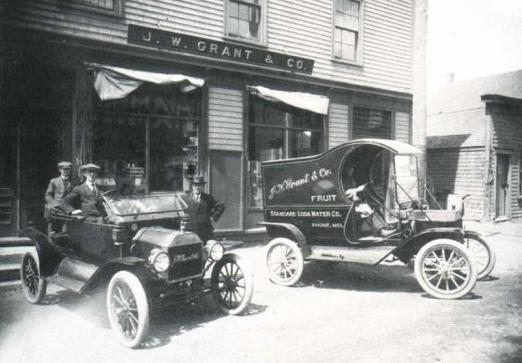
J.W. Grant, Later Yarmouth Fruit Company
corner Brown and Hawthorne Streets, Yarmouth
Date: maybe about 1920
Source:
http://www.novascotia-cyberstores.com/oldpix/build34.html
1920s
Digby Neck Bus Service
Postcard showing the bus that travelled along Digby Neck in the 1920s
http://www.rootsweb.com/~nsdigby/gallery/bus.htm
1923 April 6
About 18,000 Automobiles in Nova Scotia
Up from about 16,000 a year ago
Halifax, April 6 — The registration of motor vehicles in Nova Scotia for 1923 is now proceeding at the provincial government office. In 1922 there were about 16,000 registrations in all, and this year the total is anticipated to increase by about 2,000. Every motor vehicle permit expires on the 31st of December following its issue, and nobody is permitted to operate any motor vehicle without authorization by an official permit, and bearing the number plate issued for the current year by the department.
Registrations so far this year are away behind those of 1922, possibly due to the protracted winter conditions and heavy accumulation of snow and ice still on the streets and roads throughout the province. To yesterday [5 April 1923] only 1897 registrations had been issued, 1400 passengers and 587 commercial, compared to 3005 registrations issued by 1 April in 1922, 2230 passengers and 775 commercial.
The new motor vehicle number plates for 1923 have red raised numbers on a gray background, and are a little larger than those of previous years. The 1923 plates are six inches 15 cm high — instead of five inches 12.5 cm previously — and the numbers are five inches 12.5 cm high. The year "1923" is on the right hand side of the plate.
There are before the legislature a couple of bills that will affect motor vehicle owners and operators. One proposes an amendment to the Motor Vehicles Act to require vehicles to display a "Keep to the Right" sign card, and street railway cars to discharge and pick up passengers on the left side of the platforms. The other is an Act to regulate motor carriers, giving authority to the Public Utilities Commission to approve carriers' rates and schedules, issue operating cewrtificates, etc.
[Excerpted from the Amherst Daily News, 6 April 1923]
1923 April 6
$3,000,000 Spent by N.S. Highway Board in 1922
Halifax, April 6 — The grand total of the expenditures of the Provincial Highways Board of Nova Scotia for the year ending 31 December 1922, was $3,188,932. These figures were given in the fifth annual report of the Board, tabled in the House of Assembly [Legislature] yesterday in Halifax, by Hon. William Chisholm, Minister of Highways. The total expenditure was divided as follows:
Maintenance: $770,990 (this includes all roads, bridges, ferries, field administration, and miscellaneous)
Capital Account: $2,417,942
The report told that since the present program was inaugurated in 1918, 473.53 miles 761.91 km were now completed and the balance, 89.82 miles 144.52 km, were ninety-five per cent completed.
With the completion of the projects now under construction, federal aid money would be exhausted. The subsidy allotted to Nova Scotia was approximately $1,468,000. The Minister, in presenting the report, said that there were good hopes that more money would be available this year. He and the Chairman of the Board, A.S. MacMillan, would shortly appear before the federal government for this purpose.
The report said that 319.93 miles 514.77 km of Primary Two road had been constructed, of which 164.62 miles 264.87 km had been surfaced with gravel. The cost of construction of these roads was $349,645, an average of $1,240 per mile $771 per km.
Of Secondary One roads, 313.58 miles 504.55 km were constructed during the year, of which 55.20 miles 88.82 km was surfaced. The cost was $180,053, an average of $574 per mile $357 per km.
Mr. Chisholm spoke for an hour and a half in presenting the report of his department. He drew attention to the large mileage of Nova Scotia roads and stated that Massachusetts, with its immense population and wealth, had about the same mileage. Quebec, with a population four times as great, had little more than double the mileage, and the comparison with Ontario was about the same.
[Excerpted from the Amherst Daily News, 6 April 1923]
1923 April 9
Good Roads Association Gathers in Ottawa
Ottawa, April 9 — A deputation of the Canadian Good Roads Association, which includes prominent men of every Canadian province is gathered in Ottawa today preparatory to meeting the Prime Minister and other officials tomorrow in connection with the request that the federal aid to the Good Roads Movement shall be continued.
This afternoon, the inter-provincial conference will be held at which the plan for the government interview tomorrow will be outlined and perfected.
Among those here for the conference are:
Prince Edward Island: D.A. McKinnon, M.P.,
New Brunswick: B.M. Hill, Chief Engineer of Highways,
Nova Scotia: Hon. W. Chisholm, Minister of Highways, and A.S. MacMillan, Chairman of the Highway Board.
[Amherst Daily News, 9 April 1923]
1923 April 13
Five Hours from Amherst to Tidnish
about 35 km
Bottom out of road
The bottom, according to all reports, has completely dropped out of the country roads. It now requires between five and eight hours to get between Amherst and Tidnish [Cumberland County, Nova Scotia]. An example of the condition of the roads can be observed on Church Street [in Amherst] where the snow was recently opened up. Wagons and sleighs sink into the snow to the depth of a foot [30 cm] or more.
[Amherst Daily News, 13 April 1923]
1923 April 15 2:00am
Highway Driving Rule Changes Sides
At 2:00am on Sunday, 15 April 1923, the "rule of the road" changed, in Nova Scotia. After this day, all traffic moves on the right-hand side of the road. Previously, automobiles, streetcars, horses, bicyclists, and all other vehicles and travellers adhered to the left-hand side of the road. Since 1 December 1922 there had been a problem for automobile drivers who crossed the border between Nova Scotia and New Brunswick — on that date New Brunswick had switched to driving on the right-hand side of the road, while Nova Scotia remained with the left-side rule. For four and a half months, drivers crossing the border in both directions had to remember to change to the other side of the road, and even with the relatively low traffic levels of that day there were some near-misses resulting from this conflict.
Nova Scotia Tramways & Power Company Limited, which owned and operated the electric streetcar system in Halifax, sued the provincial government to recover the cost of changing the doors on all streetcars to the other side, and the cost of changes in track layout. In Lunenburg County, 1923 is still known as The Year of Free Beef; the price of beef dropped precipitously because oxen which had been trained to keep to the left could not be retrained — oxen are notoriously slow-witted — and many teamsters had to replace their oxen with new ones trained to keep to the right; the displaced oxen were sent to slaughter.
Nova Scotia and the Road Rule
Bridgewater Bulletin
20 March 1923
Halifax — Nova Scotia's highway traffic may be driving to the right after April 2 if the bill to be introduced by Hon. Wm. Chisholm, Minister of Highways in the provincial government, today [20 March 1923], becomes law. Notice of the bill was given Friday afternoon [16 March 1923]. It is pointed out that April 2 would be a most advantageous day to effect the change since motor vehicle traffic is prohibited on country [rural] roads during the whole of that month and horse drawn traffic would have that length of time to become familiar with the new rule of the road before the highways become infested with automobiles rendering the changed conditions more favorable to accidents.
There is also a likelihood, it is stated, that the change will be delayed in towns having tram car service, since the short time available may not be sufficient for the street car companies to make the necessary changes to their rolling stock.
There has already been considerable agitation for [---] amendment of the highway [---] in the House [Legislature] this season with a view to having the rule of the road made uniform with that which prevails throughout Canada, particularly from those members representing Cumberland County adjoining New Brunswick where the "drive to the right" rule was adopted (several months ago).
[Bridgewater Bulletin, 20 March 1923]
Notes:
• When this item was printed, the changeover was planned to take place on Monday, April 2, less than two weeks after the introduction of the enabling legislation in the House. It became evident that this was insufficient notice for some, and the change was rescheduled to Sunday, April 15th.
• [---] indicates illegible text in the source document.
• Towns in Nova Scotia with tram car service in 1923 were: Sydney, Glace Bay, Yarmouth, Trenton, New Glasgow, Stellarton, Westville, and Halifax. When the rule of the road changed from left to right, all of the approximately one hundred cars on these electric railways had to be rebuilt to move the passenger entry and exit doors from the left to the right side, and in many cars to modify the placement of the driver's controls. The street railway companies also had to make changes to their tracks and switches at some locations. These changes not only took time, but also were a serious additional expense for the companies, which in the early 1920s were having a tough time getting enough revenue to cover their ordinary expenses.
Editorial Note
Bridgewater Bulletin
27 March 1923
Drive to the right on and after April 15th. Don't forget and cause accidents. An advertising campaign should be instituted by the Government to educate the public to the change from left to right.
[Bridgewater Bulletin, 27 March 1923]
No Advertising As Yet
Editorial Comment
Amherst Daily News
14 April 1923
After Saturday, highway traffic in Nova Scotia will travel to the right. The government has passed the legislation and there it apparently has stopped, oblivious of the urgency of education.
Several months ago, after the sister province [New Brunswick] changed the rule of the road, an active publicity campaign was carried on throughout that province. Not only were New Brunswick newspapers utilized as a means of exhorting the people to drive to the right, but some of the papers of Nova Scotia were likewise employed. This paper had paid advertising from the government of New Brunswick. With concern for the welfare of the people of the province, the government of New Brunswick widely and forcefully proclaimed the change.
But how different it has been in this province! Has any one seen an advertisement in a Nova Scotia paper telling of the change? Has any one seen posters displayed? Has any one seen "Keep to the Right" signs anywhere?
The situation is a rather serious one. The change is effective Sunday at two a.m. but not a word as yet. If lives are lost, limbs broken, vehicles smashed, as a result of collisions, may not part of the balme be laid at the feet of those who failed to proclaim the change? What false economy! What inconsistency when thought is given to the hundreds of thousands that have been squandered in highway scandals alone!
We are today advised that some advertising will be done. But the fact remains that education should have preceded the change by weeks.
[Amherst Daily News, Saturday, 14 April 1923]
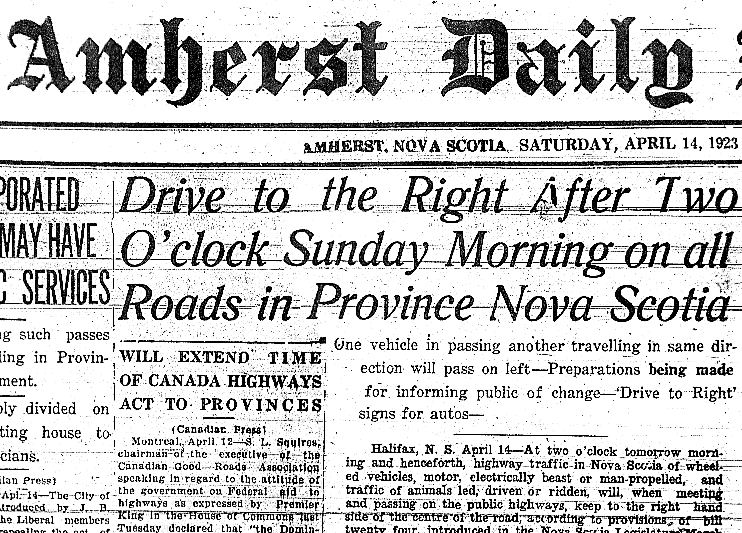
Drive to the Right on Nova Scotia Roads
Amherst Daily News, Saturday, 14 April 1923
Drive to the Right After Two O'clock Sunday Morning
Amherst Daily News
Saturday, 14 April 1923
Halifax, April 14 — At two o'clock tomorrow morning and henceforth, highway traffic in Nova Scotia of wheeled vehicles, motor, electrically, beast or man-propelled, and traffic of animals led, driven or ridden, will, when meeting and passing on the public highways, keep to the right hand side of the centre of the road, according to provisions of bill twenty-four, introduced in the Nova Scotia Legislature March 6th last and given Royal Assent in the legislative council April sixth.
Overtake on Left
By the provisions of the same act, units of traffic such as described above, when overtaking one another on the public highways, the unit overtaken will keep to the right and the overtaking unit will pass to the left, immediately returning to the right hand side of the road after assuming the leading position.
No trouble is anticipated by the officials of the Government, in spite of the fact that they had short notice to prepare their educational campaign. Every accessible district of the province will be or has been placarded with posters, public officials and school teachers are co-operating and even children are being taught the new rule because the change affects the safety of pedestrians almost as much as vehicles, particularly in the more thickly populated centres.
Posters for Autos
Automobile owners will probably be the most effective means of giving warning of the change. Every automobile has been furnished with large stickers for their windshields bearing the words "Keep to the Right." It has been suggested that large permanent posters be placed at all roads crossing the provincial boundary and at all ports of entry where vehicles for use on Nova Scotia roads are brought by tourists from other countries.
Automobile associations on the continent and a certain amount of advertising is expected to bring the news of the change to the attention of motor visitors from outside points, who may visit Nova Scotia this summer. The campaign of advertising the new rule of the road, will be carried on until July first.
In Line With Rest of Mainland
This change in the highways regulations of Nova Scotia, which was passed in the legislature last year and afterward repealed before being made effective, puts Nova Scotia in line with the other mainland provinces of the Dominion and is expected to remove a barrier that has been said to keep motorists from visitning the province on account of their fear of accidents due to their unfamiliarity of the road rule.
Whether or not the business of becoming accustomed to the drastic change will result in a series of accidents remains to be seen. The change in New Brunswick, made recently in mid-winter, was not accompanied by a single accident so far as is known. It is pointed out that in this instance the change is being made at the very beginning of busy times on roads.
The Dumb Beasts
It will be to the dumb beasts that the change will be most trying and upon country teamsters, so prone to give well trained horses "their head" the burden of responsibility will fall.
It is expected that many motorists in the city of Halifax will stay up late tonight for the novelty of being on the roads when the new order becomes effective, thus starting the week favorably by following the admonition "Keep to the Right."
[Amherst Daily News, 14 April 1923]

Drive to the Right
Amherst Daily News
Monday, 16 April 1923
|

Drive to the Right
Bridgewater Bulletin
Tuesday, 17 April 1923
|
Editorial Note: The Legislature was somewhat late in issuing advertising matter instructing vehicles to drive to the right, which law went into effect Sunday [15 April 1923]. Great care should be taken by drivers of cars and horses to go slow around corners until the new condition of things is familiar, otherwise we may expect all sorts of accidents with accompanying loss of life. Horses may be kicking the stars and oxen climbing the telephone poles, while autos calmly repose on the roadside with wheels toward the clouds.
[Bridgewater Bulletin, 17 April 1923]
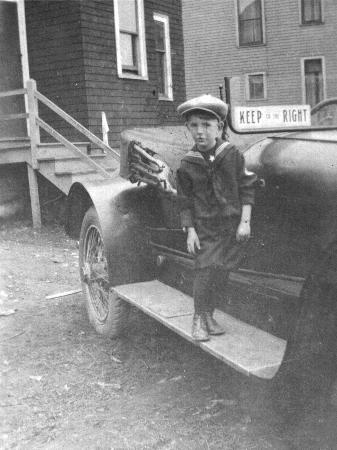
Photograph taken in the summer or fall of 1923, at Walnut Street, Halifax. The boy is Jim Sangster, then seven years old. The automobile (make and model not known) belonged to Max Manning (brother of Fred Manning, who built up the chain of Super Service gasoline stations in Nova Scotia). The historic significance of this photo lies in the message displayed on the windshield. At the time of the change of road rule from left to right, the government supplied each automobile with a large sticker for the windshield bearing the words "Keep to the Right" facing forward, as a reminder to oncoming drivers to drive on the right-hand side. The change from left to right had legally occurred on 15 April 1923, but it took time for drivers to get used to it. During the summer of 1923 there were numerous occasions when drivers forgot the new rule and lapsed into old habits. These windshield stickers were a defensive measure for drivers who wanted to reduce the chance of getting hit head-on by an oncoming vehicle on the wrong side of the road.
[The print was generously made available to me in August 1997, by Mr. Jim Sangster, age 80.]
On 1 January 1922, British Columbia changed to driving on the right-hand side of the road.
[Truro Daily News, 30 December 2000]
On 1 January 1923, British Columbia changed to driving on the right-hand side of the road.
[Branchline: Canada's Rail News Magazine, October 2005, page 3]
1923 April 16
Road Rule had a Quiet Change Sunday Morning
No accidents have been reported to the police or authorities
Sunday morning at two o'clock, the change in the road rule took effect. Despite the fact that the Provincial Government failed to advertise this important change in Provincial road law, and that the newspapers and private citizens took the matter upon themselves, the inauguration has thus far been successful. Traffic at present is extremely light — and mainly due to this no accidents were reported yesterday. One or two narrow escapes from team collisions were averted by a hair's breadth, but as no damage was done, the incidents passed unreported.
Motorists and horsemen claimed that very little trouble would result, but that it was expected that the horses on milk teams, town teams, express teams, and such vehicles, operating on regular routes [with the animals] frequently taking their own initiative, would be the ones that would suffer confusion, rather than the people.
The police had not received word of any accidents this morning, occurring over the week end.
[Amherst Daily News, Monday, 16 April 1923]
1923 April 16
Cody Stables Under New Management
The Cody Stables, up at public auction on Saturday [April 14th, 1923], will not go out of business. The stock in trade was bought on behalf of Mr. Herbert Blanche, who will act as manager, and the business will be conducted at the old stand on LaPlanche Street [in Amherst]. Although a fair crowd attended the auction, the bidding was not exceptionally high.
[Amherst Daily News, 16 April 1923]
1923 April 16
Special Stamp Cancellation
Halifax, April 16 — A special die for stamp cancelling has been sent to the postmaster at Halifax, the impression of which prints a legend calling attention to the change in the rule of the road inaugurated in Nova Scotia yesterday. This is in response to a request from the Provincial Secretary to the Post Office department at Ottawa. The special cancellation die will be used successively in Halifax, Amherst and Sydney for a period of two weeks in each place.
[Amherst Daily News, 17 April 1923]
1923 April 17
Automobile Licence Fees
Halifax, April 17 — In the Nova Scotia Legislature this evening, Mr. Corning, Conservative MLA representing Yarmouth, referred to a speech by Premier Armstrong during the early days of the session in which he said Mr. Armstrong had quoted Nova Scotian automobile licence fees as lowest in Canada, whereas he had obtained figures from Ottawa that the average rate per car in Nova Scotia was the highest in all Canada.
[Excerpted from the Amherst Daily News, 18 April 1923]
(That's all that the newspaper printed, on this subject.)
1923 April 23
Drive to the Right Slowly Taking Effect
A number of drivers of vehicles have paid little attention to the recent traffic law — Drive to the Right. Cars and teams are still parked on the left hand side of the streets in defiance of the road rule, while a number of collisions have been narrowly averted at different corners, where drivers pulled to the left rather than the right.
[Amherst Daily News, 23 April 1923]
1925 September
Halifax to Vancouver by Automobile
In September 1925 the Ford Company, in its effort to promote the concept of a Trans-Canada Highway, decided to attempt a cross-country journey by automobile. It took forty days for the Model T Ford to travel from Halifax to Vancouver.
Source:
http://www.cambrianford.com/about/history.html
1926
Nova Scotia Licence Plate
1926
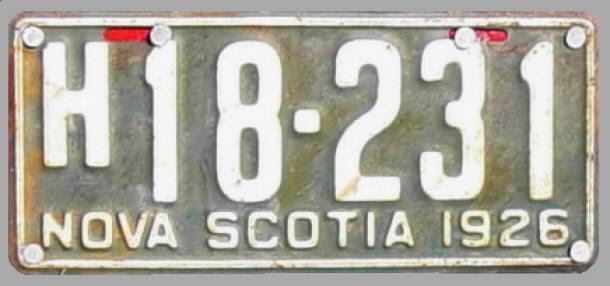
Photographed in New Ross on 2 October 2002
Thanks to Ron Barkhouse
Nova Scotia licence plates
http://epe.lac-bac.gc.ca/100/205/300/nova_scotias_electronic_attic/07-04-09/www.littletechshoppe.com/ns1625autoplates.html
1932
Cabot Trail
In 1932 Reverend R.L. MacDonald become the first person to drive the Cabot Trail. Over ten hours to travel from Cheticamp to Cape North, approximately fifty miles eighty kilometres.
Source:
http://www.cabottrail.com/info/history.htm
1932
Nova Scotia Licence Plate
1932
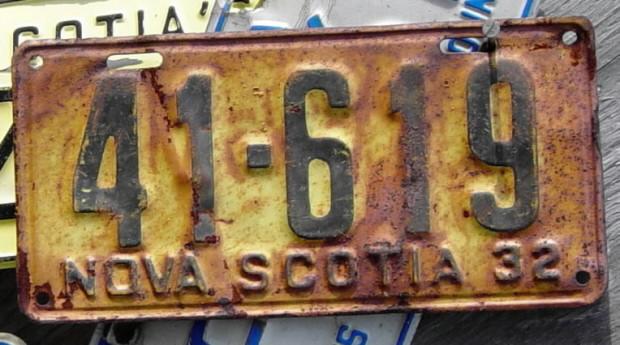
Photographed in New Ross on 2 October 2002
Thanks to Ron Barkhouse
Nova Scotia licence plates
http://epe.lac-bac.gc.ca/100/205/300/nova_scotias_electronic_attic/07-04-09/www.littletechshoppe.com/ns1625autoplates.html
1933 September
Twenty Miles of Paved Roads
In the early 1930s paving of highways became a project under consideration by the provincial government. John Hawkins in his history of the life of the Hon. Angus L. MacDonald states: "One of the pledges in Angus L. MacDonald's manifesto was to eliminate the dust nuisance on gravel roads, and to embark as soon as possible on a gradual program of hard surfacing the main highway of the Province." After Angus L MacDonald became Premier of Nova Scotia in 1933, A.S. MacMillan received the portfolio. "When A.S. MacMillan received the Highway portfolio in 1933 there were only twenty miles [about thirty kilometres] of paved road in Nova Scotia; when he relinquished his position in 1940, there were 1,000 miles [about 1500 to 1600 kilometres] of paved road in Nova Scotia."
Source:
Pictou County Reminiscences, by Stanley Graham, Scotsburn
http://www.rootsweb.com/~pictou/hiwaysg.htm
Alexander Stirling MacMillan (1870-1955) was a Member of the Legislative Assembly
(MLA) representing Digby County 1928-1933, and representing Hants County 1933-1945.
He was appointed Nova Scotia's Minister of Highways and Public Works on
5 September 1933, and served in that position until 24 February 1941.
|
1933 December 31
Numerous Gasoline Pumps
At the end of 1933 there was in the whole of Canada one retail gasoline pump installed to each 17.2 motor vehicles registered, but in Nova Scotia, at the same time, there was one pump to each 10.2 motor vehicles registered.
[1934 Annual Report of the Board of Commissioners of Public Utilities, page 319]
1940
Starting a Car
...It was in the 1940s, but Dad's car was a 1929 Hupmobile.
Once Mum and us kids were all in the car, Dad would remove the crank from the trunk at the rear of the car, walk around front, insert the crank through a hole in the bumper to the slot in the end of the engine crankshaft.
Then he would walk back to the driver's door, get in, set the hand brake, depress the clutch, put the gear shift lever in neutral, pull the choke out, pull the throttle out a ways, pull the spark lever on the steering column down to retard, turn on the ignition, get back out, walk around to the front of the car, pull up on the crank a few times until the engine caught, take the crank from the engine, put it back in the trunk, get in behind the wheel, push the choke in, ease the throttle in to idle, push the spark lever back up to advance, depress the clutch, shift into first gear, check traffic (none!), then let out the clutch, after releasing the hand brake, and we were on our merry way.
So, today you get in your car, turn the key to start, put on your seat-belt, put the gear shift lever in drive, check traffic, signal, and away you go...
Donald Lane, Scotch Village, Hants County, Nova Scotia
[Halifax Chronicle-Herald, 14 January 2003]
1933 Hupmobile, photographed in March 2001 in Canberra, Australia
http://users.esc.net.au/%7Eppub/1933-K.jpg
1930 Hupmobile Photograph
http://www.autogallery.org.ru/k/h/30hup8cyl4dr_ADC.jpg
1929 Hupmobile Photographs
http://www.theguildofautomotiverestorers.com/1929_hupmobile.htm
1927 Hupmobile Photograph
http://www.carmemories.com/cgi-bin/viewzoom.cgi?image=2779
1925 Hupmobile Photograph
http://www.roaring-twenties.com/roaring_twenties_antique_car_museum159.htm
1925 Hupmobile, photographed in March 2001 in Canberra, Australia
http://users.esc.net.au/%7Eppub/1925-E.jpg
Most people born after 1940 have never heard of the Hupmobile nor the Hupp Motor Car Company, founded by Robert and Louis Hupp ... Hupmobile was an automobile built by the Hupp Motor Company from 1909 thru 1940. The Hupp Motor Company of Detroit, Michigan, started building automobiles in 1908 ... Hupmobile made a total of 561,000 automobiles during the thirty years of production ... Hupmobiles were made for dependability more than speed, and set many endurance records. This gained a loyal marque following. In 1927 a survey showed that over 40% of Hupmobile owners were repeat buyers when their old Hupps came due for replacing. Another survey in 1937 showed that over 200,000 Hupmobiles were still licensed in the USA and 57% were still driven by their original owners ... The first police car for Detroit was a 1910 Hupmobile ... A Hupmobile finished fifth in the 1932 Indianapolis 500 race ...
Source:
The Hupmobile Club FAQ
http://clubs.hemmings.com/clubsites/hupmobile/faq.htm
|
1940
Nova Scotia Licence Plate
1940
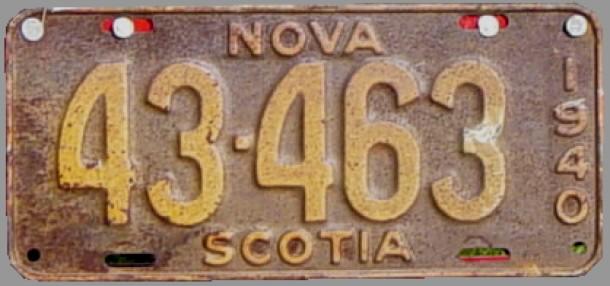
Photographed in New Ross on 2 October 2002
Thanks to Ron Barkhouse
Nova Scotia licence plates
http://epe.lac-bac.gc.ca/100/205/300/nova_scotias_electronic_attic/07-04-09/www.littletechshoppe.com/ns1625autoplates.html
1940 February
Church Sheds Disappearing
Church sheds in Nova Scotia, mute evidence of the old horse and buggy days, are becoming relics of the past. They were great places to chat. The drivers would let the women folk and children out at the church door and put their steaming steeds in the shelter. It was always rather entrancing for youngsters to see the horses taken out of the sheds after the service on a cold winter's day. Some of them perhaps had had no exercise all week, and "they were up on the bit." There was always a chance that some horse would "act up" and provide a bit of exceitment. Many drivers took quite a thrill, secretly of course, out of a prancing steed or team. The men would see what fine fettle the horses were in.
[60 Years Ago in the Berwick Register, 23 February 2000]
1941 December 12
No More Tires for Automobiles
Beginning on this day, production of tires for passenger automobiles was forbidden in Canada. This decision was put into effect just five days after the Japanese attack on Pearl Harbor on December 7th. The Japanese armed forces were advancing quickly toward Burma and other rubber-producing regions in southeast Asia, and the outlook for a continuing supply of rubber to North America was not optimistic. No tires were made for use on civilian passenger automobiles for the next thirteen months, until January 1943, when limited quantities of reclaim rubber were released.
[Toronto Globe and Mail, 16 August 1945]
1942 February 27
Automobile Registration Regulations Changed
These changes in registration expiry dates are made necessary
by regulations of the Oil Controller in connection with
the rationing of gasoline which comes into effect April 1st
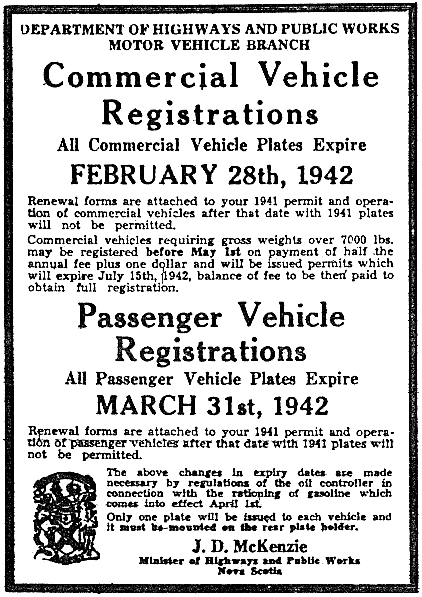
The Halifax Herald, 27 February 1942
1942 March 12
Poor Road Conditions for Freight Sleds
The recent rains have washed nearly all the snow from the main roads in western Nova Scotia, making hauling with sleds impossible. In some places, especially between Springfield and New Germany [in Lunenburg County], there is so much water on the roads, a detour is made via North River. There are two large lumbering companies operating near Springfield, and it is feared they will soon have to break camp [cease felling operations] unless colder weather comes.
[The Halifax Herald, 12 March 1942]
1942 March 18
Afternoon Deliveries Only
From now on, housewives in Kentville will have to file their grocery orders before noon if they want to receive their delivery the same day. Following the Wartime Prices and Trade Board's new edict permitting only one delivery each day, the grocery division of the Kentville Retail Merchants Association has unanimously decided to make all deliveries in the afternoon with the exception of Wednesdays. On the latter day, which is a store half-holiday, orders must be in by nine o'clock.
[The Halifax Herald, 19 March 1942]
1942 March 18
Windsor's Iron Lung Receives First Patient
Snow-blocked highway delays treatment
The Iron Lung, presented to Windsor's Payzant Memorial Hospital by the British automobile magnate Lord Nuffield, is in use for the first time, its occupant being Walter Matheson of Falmouth, former bus driver on the Halifax - Yarmouth route, suffering from paralysis of the throat following diptheria.
Mr. Matheson took ill on January 31st, and Dr. Garnet Turner attended him at his home until a crisis arrived. At this critical time, a snow blockage prevented Dr. Turner from getting to his patient.
A highways plough tried to break open the road but was unsuccessful, and it was not until a third attempt on the second day that a bulldozer, with a pung sleigh attached in which the medical man travelled, broke through the six miles ten kilometres of snow blocked highway.
Mr. Matheson had recovered from his illness and was up and around when the paralysis set in. It is a not-uncommon aftereffect of diptheria, and affects breathing and swallowing, and more commonly vision, it is said. Dr. Turnet reports a slight improvement in Mr. Matheson's condition, and has hopes that with the aid of the Iron Lung the paralysis will gradually go away and natural breathing will again take place.
[The Halifax Herald, 19 March 1942]
A pung is an oblong wooden box with runners underneath,
a sleigh with a box-shaped body.
|
1942 March 23
Motoring Over When Tires Worn Out
Munitions Minister C.D. Howe, announcing a speed limit of 40 miles per hour 65 km/h would soon become the law throughout Cnaada to conserve gasoline and rubber, told Canadian motorists that "when the tires you have now are worn out, your motoring is over until some considerable time after the war ends."
Mr. Howe, speaking over a national radio network of the Canadian Broadcasting Corporation on the evening of March 23rd, 1942, said that while confiscation of tires on non-essential cars is not an immediate prospect, "the Government will not hesitate to comandeer tires from private owners whenever that rubber is needed."
Mr. Howe appealed to Canadian motorists to conserve gasoline and rubber as a patriotic duty and to co-operate in the gasoline rationing plan which comes into effect April 1st, 1942.
He announced retreading of tires will be restricted to commercial vehicles and buses and for transportation of workers to war plants who have no alternative means of transportation.
Of Vital Concern
The conservation of rubber and gasoline is a matter of vital concern, Mr. Howe said. "If I tell you frankly that we are likely to lose the war unless we can get enough oil and enough rubber, you will understand how very serious our position is and why the conservation of these two essential materials is causing us so much anxiety," he said.
Crude oil which Canada imports provides not only gasoline for automobiles but high grade gasoline for aviation use, and light and heavy fuel oils and lubricating oil essential to the army and navy. "We are dependent upon the United States and a few other outside sources to supply us with more than eighty per cent of our petroleum requirements," Mr. Howe said.
Canadian Production of Crude Oil Cannot be Increased Much
Canada's only major oil-producing field, Turner Valley in Alberta, can meet only one-sixteenth of the country's present needs. Experts are generally agreed that the present Turner Valley oil production can not be increased safely or economically.
Imported Oil Limited by Transport Shortages
Mr. Howe said transportation is the most serious limitation in the importation of oil. "Ocean tankers are our principal source of supply," he said. "They can carry large quantities of oil and they can be operated economically, but today the tanker fleet has had to be dispersed to meet the urgent needs of all Allied nations, and fewer are available to bring oil to Canada this year than last."
"Furthermore, the attacks of submarines are making it difficult for us to maintain the size of our tanker fleet. Consequently, for the time being, we can expect no material increase in the quantity that oil tankers can deliver to our ports."
"The railway tank car situation is no more promising," he continued. "The truth is that there are not enough of them to meet the demand." The United States, engaged in a "desperate industrial race against time, has need of increasing quantities of oil and every available piece of equipment is in use. The existing supply of tank cars can not be increased because of steel shortages."
The oil pipeline between Portland, Maine, and Montreal serves only to shorten the voyage of tankers and can not be regarded as a major pipeline bringing oil to Canada, he said.
"Furthermore, because of the shortages of steel, no more pipe lines can be built," he said. "We must get along with what we have and make the best of it."
"Every endeavor has been made to see that this system of rationing is fair," the Minister said. The amount allocated for each category is the "maximum quantity of gasoline which, under present conditions, the government dares to release for these purposes."
Careful supervision is planned. "There will be no waste if the Government can prevent it," he said. "Those who try to evade the law will be dealt with severely." Motorists can give valuable assistance in two ways: by getting their gasoline ration books before April 1st, and by using less than their full ration of gasoline.
[The Halifax Herald, 24 March 1942]
1942 April 7
Only 4000 Automobiles in Reserve
J.H. Berry, motor vehicle controller in the Munitions and Supply Department, Ottawa, said on April 7th, 1942, that in future even essential automobile users will find it increasingly difficult to buy a new car. He said the last new civilian car in Canada left the assembly line about April 1st, and now there are about 4000 being held in reserve from which essential users will be supplied. "These four thousand cars, carefully stowed away by dealers centrally located all across Canada, will be the only new cars available until the end of the war," he said.
[The Halifax Herald, 8 April 1942]
1942 April 8
Home Deliveries Curtailed
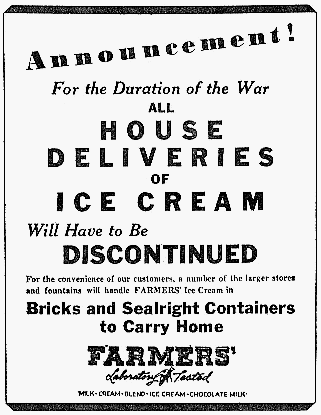
The Halifax Herald, 8 April 1942
1944
Garage Calendar 1944
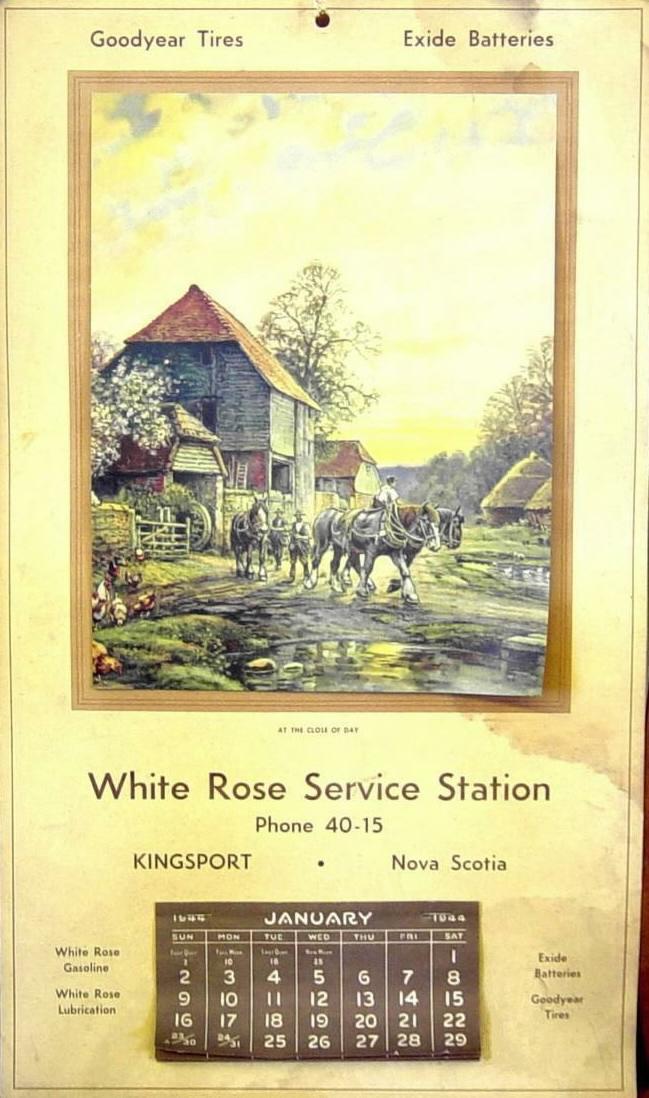
White Rose service station calendar 1944
Kingsport, Kings County, Nova Scotia
Telephone "forty ring fifteen" (a party line)
Photographed in Canning, 23 May 2003
1945 August 15
Gasoline Rationing Ended
Tire Rationing Continues
Gasoline rationing and all restrictions on the use of fuel oil in Canada were lifted this day. Similar action was taken a short time before in the United States. In knocking down the first of the consumer rationing rules, put into effect on 1 April 1942, all branches of the federal government joined (unofficially) in offering happy peace-day felicitations to all who are stuck with black market coupons.
The government also lifted all transport control restrictions on the operation of taxis, buses, and drive-yourself cars, but warned that rationing of tires must continue until stocks become available. Transport controls had prohibited sightseeing tours, restricted taxis to operations within a 15-mile 24 km radius of the community in which they ordinarily operated, limited the use of drive-yourself cars to certain specific purposes and prohibited the use of buses for charter trips.
Tire rationing cannot be abolished until the switchover from military production can be accomplished and sufficient stocks become available. However, the list of vehicle owners eligible for new tires would be broadened as soon as possible. Production of tires for passenger automobiles was forbidden in Canada five days after the Japanese attack on Pearl Harbor, December 7th, 1941, and no such tires were made for civilian use until January 1943, when limited quantities of reclaim rubber were released. In making the announcement, Munitions Minister C.D. Howe said: "I am pleased that supplies in stock and forward position warrant the discontinuance of gasoline rationing in its entirety, and of all restrictions on the supply of fuel oil." He said the government owed to Oil Controller Q.R. Cottrelle and his staff "a debt of gratitude which can never be repaid."
The first year of rationing cut consumption by more than 150,000,000 gallons 680,000,000 litres. Throughout the war, the tempo of the fighting was closely reflected in stocks on hand. The first curtailment in distribution was made in 1941 when the United States and Canada were called upon to furnish tankers to supplement supply for the United Kingdom. First there was an appeal for voluntary curtailment. But by 1942 the Dominion was down to a hand-to-mouth basis. Canada pioneered on the continent in gasoline rationing. Fuel oil was also in short supply. It became necessary in the late summer of 1942 to eliminate the use of oil for heating except for bona fide dwellings containing apartments for not more than two families. Canadian gasoline ration coupons had a value of four gallons 18 litres.
[Toronto Globe and Mail, 16 August 1945]
1946 March 30
Truro's Last Horseshoeing Shop Closes
The closing this week, of Ira D. Thompson's blacksmith and horseshoeing shop, marks the end of the last horseshoeing shop in Truro. Completing 55 years in the horseshoeing and blacksmith business in Nova Scotia, the last 40 years during which he was located in Truro and took only two weeks holidays, Mr. Thompson has retired. He has sold the blacksmith shop to W.T. Frechette. Mr. Thompson has been horseshoeing continually for 55 years, having been associated with his father, L.A. Thompson of Caledonia in Queens County, and his uncle, C.W. Thompson of Bridgewater, before coming to Truro.
He arrived in Truro on April 1st, 1901, having bought the blacksmithing property on Waddell Street from the late Harry Wright. On April 3rd, 1901, he opened for business, and has completed 45 years of service at the same stand. Through the years, Mr. Thompson has seen many changes in his line of work. When he started there were four blacksmith shops on Waddell Street alone, with many others in the town and nearby countryside. The first horse shod when the shop opened was driven by James Millar, Mount Pleasant, who has been a steady patron all through the 45 years with his own farm horses. Several other old friends remain, who have continued to make regular visits to Mr. Thompson's smithy.
[The Halifax Herald, 3 April 1946]
1946 May 14
Cumberland Gasoline Stations On Rotation
A rotation system for gasoline dealers in Cumberland County went into effect on this day. The system, for Sundays and holidays, was agreed on by the Cumberland Division of the Retail Gasoline Dealers' Association, for the period from 14 May to 31 October 1946 — the tourist season. The stated aim was to keep to a minimum the number of men employed on these special days. During this period, the schedule called for two service stations in Amherst to be open from 8:00am to 7:00pm, and one each in Springhill, Parrsboro, Oxford, and the River Hebert - Joggins area. "The Association is asking motorists to co-operate in buying their week-end fuel requirements from their regular dealers on Saturdays." The meeting was presided over by President Ira Boss of Maccan, and representatives were present from Amherst, Oxford, Parrsboro, Springhill, Maccan, Joggins, and River Hebert.
[The Halifax Herald, 3 May 1946]
1947 December 24
Long Bus Ride to Annapolis Valley
On the morning of December 24, 1947, light snow had commenced to fall in the Halifax area and by bus departure time, a respectable amount had accumulated on the ground. The Acadian Lines bus departed on time with all seats full and with about 12 to 18 standing, as was the custom in those days. Only when the bus was out of the city did it become apparent it was heading into a real, old-fashioned Nova Scotia blizzard. About one hour out of Halifax, somewhere near Mount Uniacke, all traffic stopped and there the bus was to stay until about two o'clock on Christmas morning, when a snowplow opened the road and escorted the bus into Windsor.
In Windsor, the decision was made by Acadian Lines to return the bus to Halifax and the passengers were given two options: to return to Halifax on the bus or to wait in the Windsor train station for the DAR [Dominion Atlantic Railway] train, due in about 10am. Most, including myself, chose the train option and arrangements were made to open the train station to accommodate the stranded passengers. There was no free breakfast offered in those days. The train arrived... The trip was rather pleasant by train, after the bus experience. Without any other problems, I arrived at my destination in Round Hill [Annapolis County] just about 24 hours after I had left Halifax.
Being a teenager at the time made the bus part of the trip a fun experience. I still remember the kind truck driver who, stopped in front of the bus, as he opened his truck and donated a crate of oranges to the passengers; and the very kind family in the Mount Uniacke area who made and delivered sandwiches to the bus passengers. There were about 50 passengers on the bus... As I think back, I don't remember anyone complaining that night — even about the weather...
The exact spot where the bus and all other Valley-bound traffic became immobilized by a snowstorm, I was never able to exactly determine on subsequent Valley bus trips ... The following year on Christmas Eve, I travelled home on the DAR night train and as I was the only passenger that night for Round Hill, the conductor stopped the train at the lower Round Hill crossing instead of at the Round hill station. This kindness saved me a long walk, and I remember his cheery 'Merry Christmas' as he helped me off the train...
[Excerpted from an account written fifty years later by one of the passengers on that trip, Vernon M. Spurr, then living in Dartmouth, and published in the Halifax Chronicle-Herald on 24 December 1997.]
1949 November
Stanley Steamer
Keith Boates is creating a good deal of interest with his 1922 Stanley Steamer car, which from time to time he operates in regular traffic on the streets and highways in the Annapolis Valley. The Department of Highways confirms it is the only one of its kind on the highways of Nova Scotia today.
[50 Years Ago in the Kentville Advertiser, 2 November 1999]
Nova Scotia Licence Plates
 History of Nova Scotia licence plates by David Fraser
History of Nova Scotia licence plates by David Fraser
Plate #1 was issued 8 May 1907...
http://www.gov.ns.ca/snsmr/rmv/registration/historic.stm
The Wayback Machine has archived copies of this document:
History of Nova Scotia Licence Plates
Archived: 2001 February 22
http://web.archive.org/web/20010222145825/http://www.gov.ns.ca/snsmr/rmv/registration/historic.stm
Archived: 2001 June 24
http://web.archive.org/web/20010624124612/http://www.gov.ns.ca/snsmr/rmv/registration/historic.stm
|
 Nova Scotia licence plates by Joseph P. Sallmen
Nova Scotia licence plates by Joseph P. Sallmen
http://www.canplates.com/ns.html
 Nova Scotia licence plates before 1957 by Marc Welby
Nova Scotia licence plates before 1957 by Marc Welby
http://www.plateshack.com/novascotia/novascotia2.html
Nova Scotia licence plates after 1958 by Marc Welby
http://www.plateshack.com/novascotia/novascotia.html
 Nova Scotia licence plates by David Nicholson
Nova Scotia licence plates by David Nicholson
http://www.15q.net/ns.html
 Nova Scotia licence plates by Nick Kanaya
Nova Scotia licence plates by Nick Kanaya
http://www.geocities.com/MotorCity/Speedway/1151/SAMPLE-NS2.html
1951
Nova Scotia Licence Plate
1951
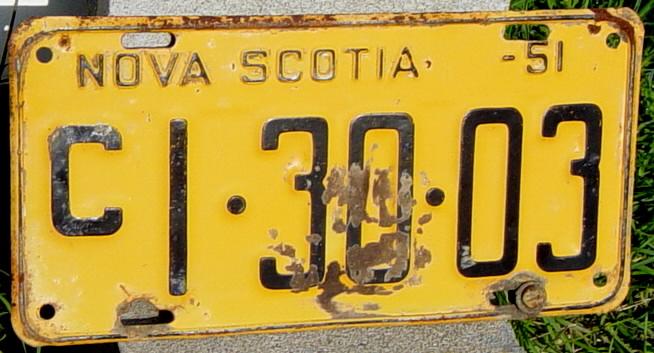
Photographed in New Ross on 2 October 2002
Thanks to Ron Barkhouse
Nova Scotia licence plates
http://epe.lac-bac.gc.ca/100/205/300/nova_scotias_electronic_attic/07-04-09/www.littletechshoppe.com/ns1625autoplates.html
Nova Scotia Driver's Licence, 1955
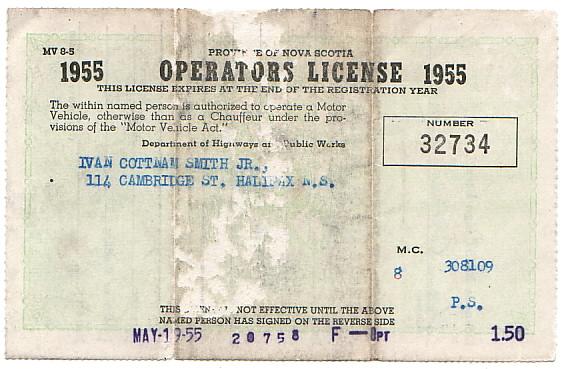
1955 Nova Scotia driver's licence, front
13.9cm by 8.8cm
(Showing wear from being carried folded in a wallet for a year.)
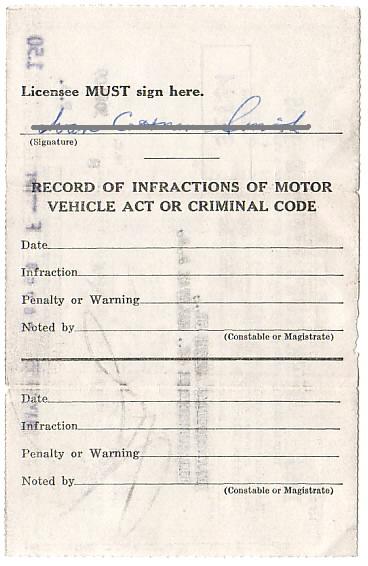
1955 Nova Scotia driver's licence, back
Halifax - Dartmouth Bridge tickets, 1957

Halifax - Dartmouth Bridge Commission
Ticket Book cover
15.4cm by 5.2cm
|

Halifax - Dartmouth Bridge Commission
25 tickets for $1.00
Each ticket good for
one trip for one person,
passenger or pedestrian
|
The original toll, when the bridge opened in 1955, was 40 cents for a car and driver,
15 cents for motorcycles, and 5 cents for each pedestrian and vehicle passenger.
The Angus L. MacDonald Bridge was opened officially on 2 April 1955.
|
Auto Repair Bill, 1959

Envelope postmark, 2 July 1959
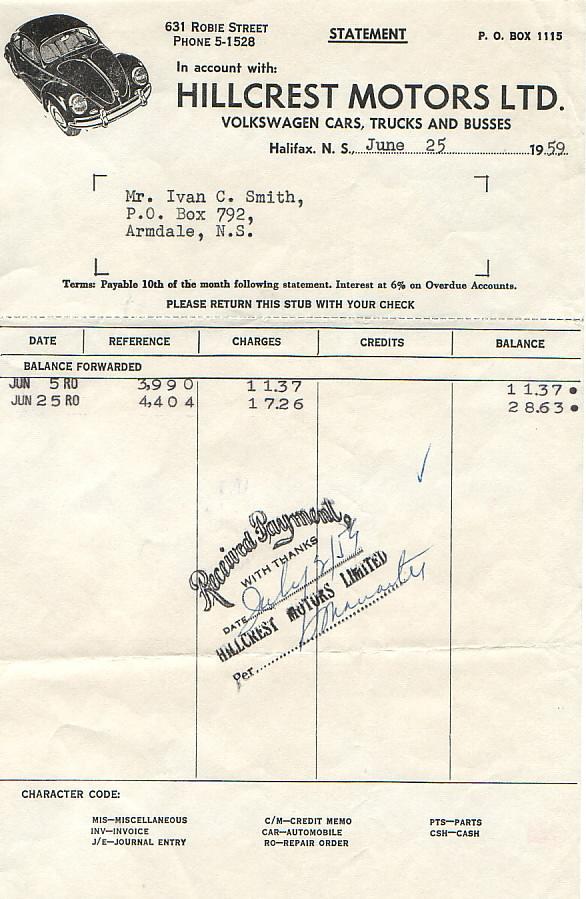
Volkswagen repair bill, 25 June 1959
Oldest Car in Atlantic Canada
September 2000
1902 Columbia Electric
98-year-old car to be featured at Sherbrooke show
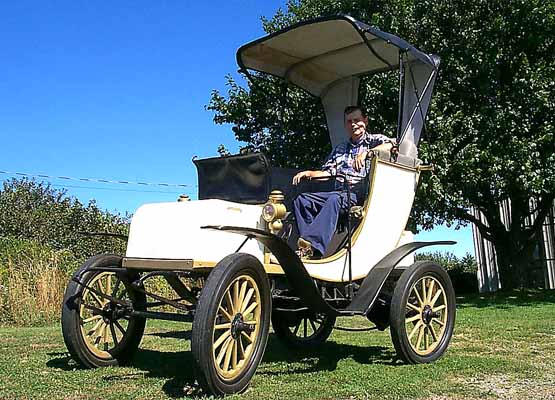
This 1902 Columbia Electric automobile, owned by
Willard Saulnier of Meteghan, Digby County, Nova Scotia,
is the oldest operating car in Atlantic Canada.
Note the acetylene headlights.
There are old cars, there are antique cars and there is the car Willard Saulnier will take to the annual Sherbrooke Show and Shine in September.
The Meteghan man's 1902 Columbia Electric Car, the oldest operating car in Atlantic Canada, will be featured among 200 vehicles from around the Maritimes Sept. 9th and 10th. "It's one of the first cars made after the horse-drawn carriage," Mr. Saulnier said. "It's the only one I know of in Canada."
The mostly wooden vehicle runs on six six-volt batteries, which will last for about 14 hours after a complete charging. But it will never set any speed records. "It will go about 20 miles (about 30 kilometres) per hour," said Mr. Saulnier, who bought the two-seater treasure six months ago from a Yarmouth man.
"It would probably take me about a month to drive" to Show and Shine, which will be held on the ball field at historic Sherbrooke Village from 11am to 5pm Saturday September 9th and from 10am to 4pm Sunday September 10th.
Drivers and owners will be available both days to talk about their vehicles.
The cars will parade through the streets of Sherbrooke at 5:00pm Saturday as they begin a drive to Sonora. They'll return to Sherbrooke later in the evening.
Mr. Saulnier's car, with a rudimentary 18-horsepower motor, has been a hit at a dozen car shows this year. This winter, he hopes to fully restore the vehicle, which was salvaged from an old barn in Ontario several years ago.
[Halifax Chronicle-Herald, 30 August 2000]
References — Sherbrooke Village
Sherbrooke Village website at
http://museum.gov.ns.ca/sv/
Sherbrooke Show & Shine website at
http://museum.gov.ns.ca/sv/shine/
References — History of Electric Automobiles
Advertisement for the 1897 Columbia Electric Car, by the Pope Manufacturing Company
http://detroitlocal.com/museum/room2.html
Good photograph of a 1901 Columbia Electric
http://motionalmemories.com/1901-Columbia-Electric.htm
Electric cars called the Columbia were produced from 1897 to 1907 by a succession of companies operating in Hartford, Connecticut.
Pope Manufacturing Company from 1987 to 1899
Columbia Automobile Company in 1899
Columbia & Electric Vehicle Company in 1900
Electric Vehicle Company from 1901 to 1909.
Some 500 of these cars were produced by the end of 1898. Gasoline cars were built by the same companies starting in 1899. A 1901 Columbia is in the holdings of the Henry Ford Museum in Dearborn, Michigan.
Source: http://www.econogics.com/ev/evhistry.htm
Some EV History: a history of some of the makes, marques and movers in the history of on-road EVs...
http://www.econogics.com/ev/evhistry.htm
A History of Early Electric Cars, by Paul A. Hughes
http://www.geocities.com/Athens/Crete/6111/electcar.htm
History of Electric Cars, 1834 - 1987, by Frank Didik
http://www.didik.com/ev_hist.htm
Columbia Chronology
http://www.columbiamfginc.com/historydoc.htm
Columbia Chronology
http://rusty-spokes.com/facts.html
Columbia Chronology
http://www.firstflightbikes.com/columbia.htm
History of Electric Vehicles, by United States Department of Energy
http://ev2.inel.gov/sop/general_info/history.html
Motor Age: At least 14 companies were making electric vehicles in January of 1909...
http://www.motorage.com/edindex/1900.htm
Photos of early Electric Vehicles
http://spock.york.tec.sc.us/~kosak/EVSPAST.HTM
EV speed records — 1904, a Baker Electric reached a speed of 104 mph at Daytona Beach, Florida
http://spock.york.tec.sc.us/~kosak/RECORDS.HTM
In 1899, the first speeding ticket ever given to any type of vehicle was issued to a Manhattan electric taxi...
http://spock.york.tec.sc.us/~kosak/evsrunin.htm
List of U.S. automobile manufacturers — including Columbia Electric, 1897-1913
http://members.magnet.at/customcruisers/Carmake/Carmakes.htm
The birth of the automobile industry in the United States took place in Hartford. The Pope Manufacturing Company using the best manufacturing methods then known, made Columbia Electric Automobiles. For many years Hartford was the center of the automobile industry The first time a President of the United States ever rode in an automobile was August 22, 1902, when President Theodore Roosevelt took a ride in Hartford...
http://grhartfordcvb.com/mp-visitor-facts.html#firsts
Notes
In 1907, The Eastern Chronicle was published twice a week, Tuesdays and Fridays, in New Glasgow, Pictou County, Nova Scotia.
Wayback Machine
Wayback Machine
http://web.archive.org/index.html
"Use the Wayback Machine to view web sites from the past."
Archive of This Document:
History of Automobiles in Nova Scotia
The Wayback Machine has copies of this webpage from the early days:
Archived: 2002 January 10
http://web.archive.org/web/20020110062925/http://www.alts.net/ns1625/automobiles.html
Archived: 2002 August 16
http://web.archive.org/web/20020816123730/http://www.littletechshoppe.com/ns1625/automobiles.html
Archived: 2002 November 08
http://web.archive.org/web/20021108172734/http://www.littletechshoppe.com/ns1625/automobiles.html
Archived: 2003 February 10
http://web.archive.org/web/20030210142743/http://www.littletechshoppe.com/ns1625/automobiles.html
Archived: 2003 August 01
http://web.archive.org/web/20030801152645/http://epe.lac-bac.gc.ca/100/205/300/nova_scotias_electronic_attic/07-04-09/www.littletechshoppe.com/ns1625automobiles.html
Archived: 2004 February 03
http://web.archive.org/web/20040203112634/http://www.littletechshoppe.com/ns1625/automobiles.html
|
Nova Scotia licence plates
http://epe.lac-bac.gc.ca/100/205/300/nova_scotias_electronic_attic/07-04-09/www.littletechshoppe.com/ns1625autoplates.html
Go To: History of Railway Companies in Nova Scotia
http://epe.lac-bac.gc.ca/100/205/300/nova_scotias_electronic_attic/07-04-09/www.littletechshoppe.com/ns1625railways.html
Go To: History of Telegraph and Telephone Companies in Nova Scotia
http://epe.lac-bac.gc.ca/100/205/300/nova_scotias_electronic_attic/07-04-09/www.littletechshoppe.com/ns1625telephone.html
Go To: History of Electric Power Companies in Nova Scotia
http://epe.lac-bac.gc.ca/100/205/300/nova_scotias_electronic_attic/07-04-09/www.littletechshoppe.com/ns1625electric.html
Go To: Index to other online Nova Scotia History
http://epe.lac-bac.gc.ca/100/205/300/nova_scotias_electronic_attic/07-04-09/www.littletechshoppe.com/ns1625histindx.html
Go To: Home Page
http://epe.lac-bac.gc.ca/100/205/300/nova_scotias_electronic_attic/07-04-09/www.littletechshoppe.com/ns1625index.html


Counter started 30 May 2002

W3C HTML Validation Service
http://validator.w3.org/

W3C CSS Validation Service
http://jigsaw.w3.org/css-validator/
First uploaded to the WWW: 2001 December 30
Latest content revision: 2006 May 13






















